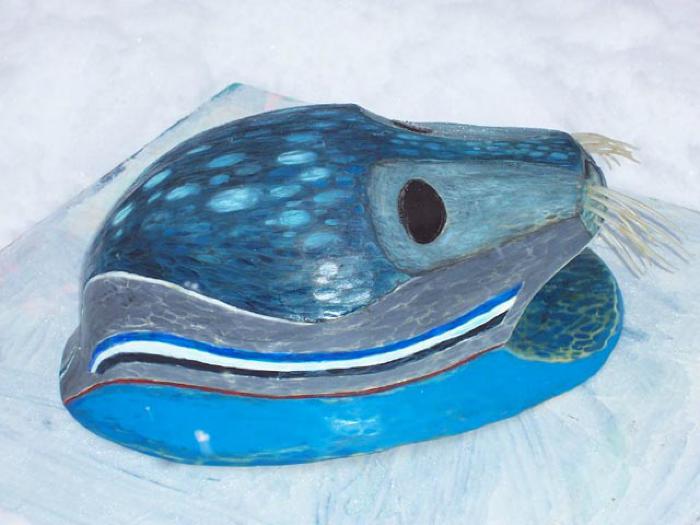Head — Nasquq
Nasquqa allrani anq’rtaartuq. – My head sometimes hurts.

Photo: Seal helmet carving by Lena Amason, 2005. Purchased for the Alutiiq Museum collection with support from the Rasmuson Foundation.
Covering the head is an important part of staying warm in cold, wet, or windy conditions, like those found on Kodiak. Alutiiq people designed a great variety of hats to protect their heads and retain heat. Unlike the skin clothing of far northern Alaska, Alutiiq parkas did not include a hood. People wore long robes with a short, loose-fitting, standup collar, like a mock turtleneck. The one exception was the gut skin rain jacket, a waterproof, hooded garment designed for protection from rain and sea spray. These jackets had a close-fitting, lightweight hood that covered the head and neck. Equipped with a string, the jacket’s hood could be drawn tightly around the wearer’s face so that the head was entirely covered. In addition to keeping your hair dry, this design prevented water from running down the back of your parka!
Alutiiq people fashioned other headgear from wood, spruce root, and animal tissues. In their kayaks, men wore elaborately decorated hats and visors bent from wood. In addition to shielding their faces from rain and glare, these hats were a type of amulet, an object that provided spiritual assistance with the hunt. Helmets carved in the shape of a seal’s head were another type of hunting hat. Shaped like a hard hat, these hats featured a seal’s head on the crown, as if the animal were poking its head out of the water. Wooden figurines from archaeological sites depict hunters wearing these helmets and illustrate that this type of hat is hundreds of years.
Alutiiq people fashioned other headgear from wood, spruce root, and animal tissues. In their kayaks, men wore elaborately decorated hats and visors bent from wood. In addition to shielding their faces from rain and glare, these hats were a type of amulet, an object that provided spiritual assistance with the hunt. Helmets carved in the shape of a seal’s head were another type of hunting hat. Shaped like a hard hat, these hats featured a seal’s head on the crown, as if the animal were poking its head out of the water. Wooden figurines from archaeological sites depict hunters wearing these helmets and illustrate that this type of hat is hundreds of years.
Alutiiq women made other hats by weaving spruce roots into round-rimmed caps, or stitching skins into tall, narrow headdresses. Like wooden hats, these garments were colorful and elaborately decorated. Spruce root hats were painted with geometric designs or animal faces, and embellished with beads and dentalium shells. Skin hats featured a stunning mix of bird and mammal tissues, with decorations of puffin beaks, tufts of hair, and embroidery. And in the historic era, Alutiiq ladies crafted beautiful gutskin hats modeled after the caps of Russian seafarers.
